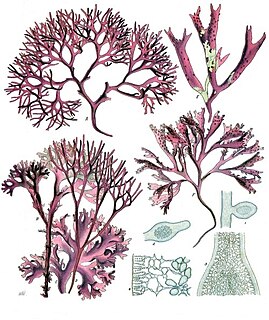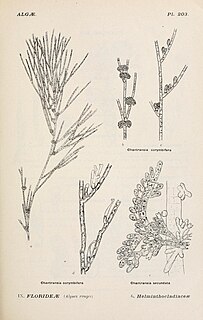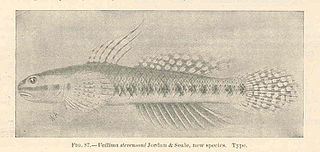
Algae is an informal term for a large and diverse group of photosynthetic eukaryotic organisms. It is a polyphyletic grouping that includes species from multiple distinct clades. Included organisms range from unicellular microalgae, such as Chlorella, Prototheca and the diatoms, to multicellular forms, such as the giant kelp, a large brown alga which may grow up to 50 metres (160 ft) in length. Most are aquatic and autotrophic and lack many of the distinct cell and tissue types, such as stomata, xylem and phloem, which are found in land plants. The largest and most complex marine algae are called seaweeds, while the most complex freshwater forms are the Charophyta, a division of green algae which includes, for example, Spirogyra and stoneworts.

Chlamydomonas is a genus of green algae consisting of about 325 species all unicellular flagellates, found in stagnant water and on damp soil, in freshwater, seawater, and even in snow as "snow algae". Chlamydomonas is used as a model organism for molecular biology, especially studies of flagellar motility and chloroplast dynamics, biogenesis, and genetics. One of the many striking features of Chlamydomonas is that it contains ion channels (channelrhodopsins) that are directly activated by light. Some regulatory systems of Chlamydomonas are more complex than their homologs in Gymnosperms, with evolutionarily related regulatory proteins being larger and containing additional domains.
In biology, a homonym is a name for a taxon that is identical in spelling to another such name, that belongs to a different taxon.

The Jamaican slider also known as the Cat Island slider is a species of fresh water turtle in the family Emydidae. It is found in the Bahamas and Jamaica. As it is not currently found on any of the other surrounding islands in the region it is assumed that the Jamaican slider was introduced from one of these countries to the other. Even though the popular theory was that these turtles originated from Jamaica, current geological evidence may suggest that they were in the Bahamas long before the native Indians first went to the Bahama islands. There is also evidence from archeological sites on San Salvador that the native Indians ate these turtles and transplanted them around the West Indies.

Red algae, or Rhodophyta, are one of the oldest groups of eukaryotic algae. The Rhodophyta also comprises one of the largest phyla of algae, containing over 7,000 currently recognized species with taxonomic revisions ongoing. The majority of species (6,793) are found in the Florideophyceae (class), and mostly consist of multicellular, marine algae, including many notable seaweeds. Red algae are abundant in marine habitats but are relatively rare in freshwaters. Approximately 5% of the red algae occur in freshwater environments with greater concentrations found in warmer areas. Except for two coastal cave dwelling species in the asexual class Cyanidiophyceae, there are no terrestrial species, which may be due to an evolutionary bottleneck where the last common ancestor lost about 25% of its core genes and much of its evolutionary plasticity.

Edible seaweed, or sea vegetables, are seaweeds that can be eaten and used in the preparation of food. They typically contain high amounts of fiber. They may belong to one of several groups of multicellular algae: the red algae, green algae, and brown algae.

Gibbonsia elegans, the spotted kelpfish, is a species of clinid native to subtropical waters of the Pacific Ocean from central California, U.S. to southern Baja California, Mexico. It prefers subtidal rocky habitats with seaweed down to a depth of about 56 metres (184 ft). This species can reach a maximum length of 16 centimetres (6.3 in) TL. This species feeds on benthic crustaceans, gastropods, and polychaete worms. Gibbonsia is named after Dr. William P. Gibbsons who was a naturalist in the California Academy of Science. It is found in three different colors depending on their habitat. Males and females do not show sexual dimorphism.

Draconichthys elegans is a selenosteid arthrodire placoderm from the Late Frasnian Kellwasserkalk facies of the Anti-Atlas Mountains of what is now Morocco. During the Late Devonian, the region would have been a shallow, algae-dimmed sea.
Chondracanthus elegans is a red algae species in the genus Chondracanthus. The name elegans is Latin for 'elegant.'
Corallina elegans is a species of red algae in the family Corallinaceae from the Mediterranean Sea and the North Atlantic Ocean.

Acrochaetium is a genus of marine red alga.

Colaconema is a genus of marine red algae.
Delisea elegans is a species of red algae.
Cruoriella elegans is a species of red algae in the family Peyssonneliaceae. It is found in the southern islands of Japan.

Kyphosus elegans, the Cortez sea chub or Cortez chub, is a species of marine ray-finned fish, a sea chub from the family Kyphosidae. It is found in the eastern Pacific Ocean where it is of minor importance to commercial fisheries.
Pythium porphyrae, is a parasitic species of oomycete in the family Pythiaceae. It is the cause of red rot disease or red wasting disease, also called akagusare (赤ぐされ) in Japanese. The specific epithet porphyrae (πορφυρα) stems from the genus of one of its common hosts, Porphyra, and the purple-red color of the lesions on the thallus of the host. However, many of its hosts have been moved from the genus Porphyra to Pyropia.

Stiphodon elegans is a species of freshwater goby. It is found in Polynesia, from Wallis and Futuna, Samoa, Cook Islands and French Polynesia. It occurs in clear, fast flowing streams in rainforest near the coast and it feeds on algae.
Griffithsia elegans is a species of red algae in the family Wrangeliaceae. It is found in Australia and New Zealand. The type locality is Robe, South Australia.
Aspidosiphon elegans is a species of unsegmented benthic marine worm in the phylum Sipuncula, the peanut worms. It is a bioeroding species and burrows into limestone rocks, stones and corals. It occurs in the western Indo-Pacific region, the Red Sea, and the tropical western Atlantic Ocean, and is invasive in the eastern Mediterranean Sea.










